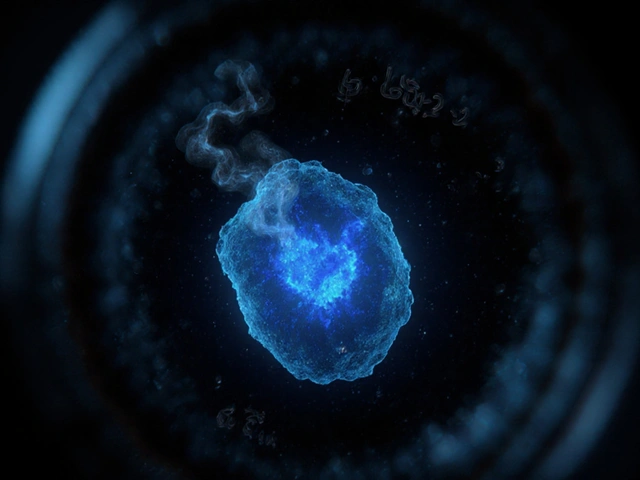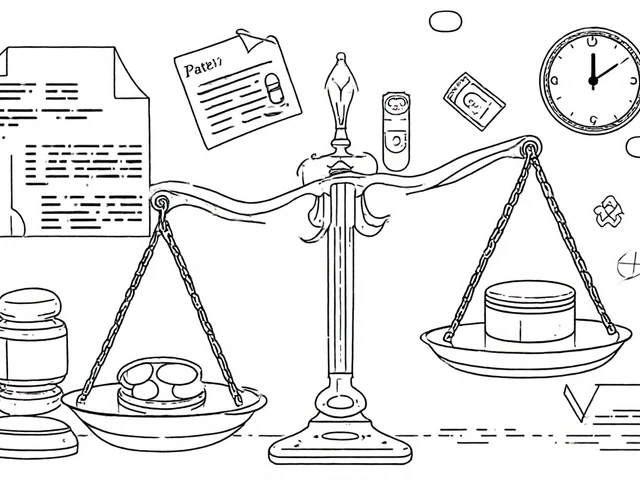Tonic-clonic seizures in infants is a type of seizure characterized by sudden stiffening (tonic phase) followed by rhythmic jerking (clonic phase) that occurs in children under 12 months. These events are medical emergencies because the developing brain is highly vulnerable.
- Identify common causes quickly.
- Recognize key symptoms to act fast.
- Know first‑line treatments and when to seek specialist care.
Why do infants experience tonic‑clonic seizures?
Seizure triggers in babies differ from those in older kids. The brain is still forming, so genetic, metabolic, structural, and infectious factors can tip the balance.
Infant epilepsy is a broader diagnostic category that includes recurrent seizures of any type before age one. It often signals an underlying neurological disorder, and tonic‑clonic episodes are one of its most visible manifestations.
Genetic mutations-such as SCN1A, KCNQ2, or PRRT2-disrupt ion channel function, leading to hyper‑excitable neurons. Studies from the UK National Health Service (NHS) show that up to 30% of infant seizures have a confirmed genetic basis.
Metabolic disorders-including hypoglycemia, urea cycle defects, and pyridoxine‑dependent epilepsy-alter the brain’s energy supply. A 2023 review in the Journal of Pediatric Neurology found that metabolic screening catches 10‑15% of cases that would otherwise be labeled idiopathic.
Structural abnormalities-like cortical malformations or hemorrhagic lesions-can be spotted on imaging. In a cohort of 200 infants, magnetic resonance imaging (MRI) identified a clear cause in 22% of tonic‑clonic events.
Infections such as viral encephalitis or meningitis also provoke seizures, especially when fever spikes sharply. Fever‑induced seizures are usually brief and generalized, but a prolonged tonic‑clonic episode may signal a more serious process.
Spotting the seizure: symptoms and signs
A tonic‑clonic seizure in a newborn often starts with a sudden loss of muscle tone. The infant may become floppy (tonic loss) for a few seconds, then erupt into rhythmic jerks that involve the entire body. Key observations include:
- Loss of consciousness or unresponsiveness.
- Stiffening of limbs followed by bilateral jerking.
- Blue‑tinged lips or difficulty breathing due to airway obstruction.
- Post‑ictal drowsiness lasting minutes to hours.
- Possible tongue biting or incontinence.
Because infants cannot verbalize discomfort, caregivers should watch for subtle cues-eye deviation, drooling, or a sudden change in feeding pattern.
Electroencephalogram (EEG) is a diagnostic test that records brain electrical activity. During a seizure, EEG shows characteristic spikes and slow waves, helping differentiate epileptic from non‑epileptic events.
Getting a diagnosis: the clinical work‑up
The first step after a witnessed seizure is to stabilize the airway, breathing, and circulation. Once the baby is safe, the following investigations are typically ordered:
- Blood tests: glucose, electrolytes, calcium, magnesium, ammonia, and a metabolic panel.
- Genetic testing: panel sequencing for common epilepsy genes.
- Neuroimaging: MRI (preferred) or head CT if MRI is unavailable.
- EEG: performed within 24‑48hours of the event.
Magnetic Resonance Imaging (MRI) provides high‑resolution pictures of the brain’s structure. It can reveal cortical dysplasia, hemorrhage, or tumors that may be causing seizures.
When the cause remains unclear after these tests, clinicians may call it “idiopathic infantile epilepsy” and start empirical treatment.
First‑line treatments: what works and when
The goal is to stop the seizure quickly and prevent recurrence. Treatment choices depend on cause, severity, and age.
Antiepileptic drugs (AEDs) are medications that stabilize neuronal membranes. Common first‑line agents for infants include phenobarbital, levetiracetam, and benzodiazepines for acute control.
- Phenobarbital: Often the initial drug because it can be given IV and has a long half‑life. Dosing is 3‑5mg/kg loading, then 1‑3mg/kg daily.
- Levetiracetam: Gaining popularity due to a favorable side‑effect profile. Typical infant dose is 20‑30mg/kg twice daily.
- Benzodiazepines (e.g., lorazepam) are used for status epilepticus-continuous seizure lasting >5minutes.
If a metabolic disorder is identified, specific therapies such as pyridoxine (vitaminB6) for pyridoxine‑dependent epilepsy are administered immediately.
For refractory cases, the ketogenic diet-a high‑fat, low‑carbohydrate regimen-has shown seizure reduction in up to 50% of infants after three months, according to a 2022 multicenter trial.

Comparing the main cause categories
| Cause | Typical Onset Age | Common Triggers | Key Diagnostic Test | First‑Line Treatment |
|---|---|---|---|---|
| Genetic Mutation | First 3 months | None (spontaneous) | Gene panel sequencing | Phenobarbital or Levetiracetam |
| Metabolic Disorder | Neonatal period | Fasting, illness | Metabolic panel, ammonia | Targeted metabolic therapy (e.g., pyridoxine) |
| Structural Abnormality | 0‑6months | Head trauma, hemorrhage | MRI | Surgical consult or AEDs |
| Febrile/ Infectious | 6‑12months | High fever, viral infection | CSF analysis, EEG | Fever control, AEDs if prolonged |
Long‑term outlook and developmental considerations
Seizure control dramatically improves neurodevelopmental outcomes. A longitudinal study from the University of Bristol (2021) followed 120 infants with tonic‑clonic seizures; those who achieved seizure freedom by six months scored on average 12 points higher on the Bayley Scales of Infant Development.
Early intervention services-physiotherapy, speech therapy, and occupational therapy-are recommended for any infant who has experienced a seizure, even if the cause is treatable.
Regular follow‑up with a pediatric neurologist ensures that medication levels stay therapeutic and that emerging developmental concerns are addressed promptly.
Practical steps for parents and caregivers
When a seizure starts, time is critical. Here’s a quick action plan:
- Call emergency services (999 in the UK) if the seizure lasts longer than 5minutes or the baby has breathing difficulties.
- Place the infant on their side to keep the airway clear.
- Do NOT put anything in the mouth; remove loose clothing only.
- Note the start time, duration, and any observed triggers.
- After the event, keep the baby warm and monitor breathing before transport.
Keep a seizure diary-date, time, duration, possible trigger, medication taken. This record helps the neurologist fine‑tune treatment.
Related concepts and next steps
Understanding tonic‑clonic seizures opens the door to broader topics in pediatric neurology. You may want to explore:
- Infantile spasms: another seizure type with a very different treatment pathway.
- Sudden infant death syndrome (SIDS): how seizure activity can mimic SIDS symptoms.
- Neonatal hypoxic‑ischemic encephalopathy: a cause of early‑life seizures linked to birth complications.
Each of these areas shares diagnostic tools (EEG, MRI) and often overlaps with the management strategies discussed above.

Frequently Asked Questions
What is the difference between a tonic-clonic seizure and a febrile seizure?
A tonic-clonic seizure involves a full-body stiffening followed by rhythmic jerking, while a febrile seizure is usually brief (<5min), generalized, and directly linked to a rapid rise in body temperature. Both can occur in infants, but tonic-clonic episodes often indicate an underlying neurological disorder that needs deeper investigation.
Can genetic testing determine the cause of my baby’s seizures?
Yes. Panels that screen for epilepsy‑related genes (e.g., SCN1A, KCNQ2) identify a pathogenic mutation in roughly 30% of infants with unexplained seizures. A positive result guides medication choice and informs family planning.
When should I administer emergency medication at home?
If your pediatric neurologist has prescribed a rescue benzodiazepine (e.g., rectal diazepam or nasal midazolam), you can give a dose when a seizure lasts longer than 2minutes or if breathing becomes shallow. Always follow the exact dosage and then call emergency services.
Will my baby need ongoing medication after the first seizure?
Not always. If the seizure was provoked by a reversible metabolic issue and the underlying cause is corrected, the doctor may monitor without immediate long‑term AEDs. However, many infants with idiopathic or genetic causes start low‑dose medication to prevent recurrence.
How often should my infant have follow‑up EEGs?
Typically, an initial EEG is done within 24‑48hours of the event. A repeat EEG after 1‑3months helps assess treatment response. More frequent monitoring may be needed if seizures persist or medication levels are adjusted.
Are there lifestyle changes that reduce seizure risk?
Maintaining stable feeding schedules, avoiding prolonged fasting, and promptly treating fevers can lower the chance of triggered seizures. For metabolic disorders, specific dietary restrictions (e.g., low‑protein) are essential.




Comments
10 Comments
Jessica Ainscough
Just wanted to say this guide is so clear and helpful. I’m a NICU nurse and we see these seizures more than people realize. The breakdown of causes vs treatments? Gold. Took me years to piece this together from scattered papers.
Also, that seizure diary tip? Life-changing for parents. I always hand out a printable template now. Small thing, huge impact.
May .
Phenobarbital is still first line? Really?
Sara Larson
THIS. 🙌 I had a friend whose baby had a tonic-clonic seizure at 4 months and the ER docs just said 'it's probably just fever'-turned out to be KCNQ2 mutation. This guide saved her sanity.
Also-Ketogenic diet isn't just for adults anymore. My cousin’s 8-month-old went from 15 seizures a day to zero in 10 weeks. Life-changing. 💪
Josh Bilskemper
Phenobarbital is outdated. Levetiracetam is the only rational choice. Anyone still using phenobarbital is practicing 1980s medicine. Also why are you still using MRI instead of high-res DTI? This guide is amateur hour.
Storz Vonderheide
As someone raised in a rural community where neurology access was nonexistent, this article feels like a gift. I’ve seen too many families get dismissed because 'babies just jerk sometimes.'
That table comparing causes? Perfect for sharing with community health workers. We translated it into Spanish and Hausa for our clinics. Knowledge shouldn’t be a privilege.
dan koz
Bro in Nigeria we don't even have EEG machines in most hospitals. You talking about MRI and gene panels like it's Walmart.
Real talk: if your baby seizes and you're in rural Enugu, you pray, give cool water, and run to the clinic. No one cares about pyridoxine here. This guide is academic luxury.
Kevin Estrada
OMG I just watched a TikTok of a baby having a seizure and I swear it was exactly like this!!
My cousin’s kid had one and now she’s on like 5 meds and they say she might never walk?? I cried for 3 hours. Is this gonna kill her??
Also I think it’s because of the vaccines. Just saying. 🤔
Katey Korzenietz
How can you even recommend phenobarbital? It causes cognitive decline. This is negligence. I’ve read the Lancet studies. You’re putting babies at risk. Shame.
Ethan McIvor
It’s wild how much we’ve learned about infant neurology in the last decade. But what really hits me is the emotional weight behind this. Parents aren’t just dealing with seizures-they’re wrestling with guilt, fear, and the terrifying unknown.
This guide doesn’t just inform. It holds space. And that matters more than we admit.
Mindy Bilotta
Just wanted to add-when they say 'idiopathic' it doesn't mean 'no cause.' It means we haven't found it yet. Don't give up on testing. My daughter was labeled idiopathic at 5 months. At 11 months, a whole exome seq found a new SCN1A variant. Now she's on stiripentol and thriving.
Keep pushing. And yes, the ketogenic diet works. Just be patient. 💛
Write a comment